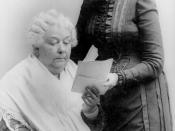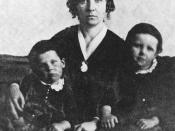The 19th Amendment
In 1920, the adoption of the 19th Amendment gave women the right to vote. When the Constitution was adopted in 1789, the right to vote, or suffrage, was restricted to certain groups of people. Among this group were men, those who were wealthy or owned property, and Caucasians.
The women's suffrage movement began in 1848, with a convention in New York. The Seneca Falls convention was called by two women, Elizabeth Cady Stanton and Lucretia Mott. Stanton was later president of two prominent suffrage organizations, the National Women Suffrage Association and the National American Woman Suffrage Association. A Declaration of Sentiments, similar to the Declaration of Independence, was introduced at the suffrage convention.
Suffrage for women had many opponents, mostly men. The men believed that women could not represent themselves as well as
their husbands because they were thought to be less intelligent. Some also believed that it would destroy family life.
Support for suffrage really took off after the 15th Amendment, which allowed blacks to vote, was adopted. In 1872, Susan B. Anthony and several other women were arrested for voting in the presidential election. Anthony attracted national attention at her trial with a moving speech which ending with her famous quote "Resistance to tyranny is obedience to God."
By the next century, new, more conservative, leaders like Carry Catt and Maud Park found support from middle class women. They lobbied congress and used marches, pickets, and protests to gain more support. Some suffragettes went so far as to stage hunger strikes. Others purposefully got arrested and sent to jail.
By 1918, the suffragettes had gained the support of President Woodrow Wilson. The House of Representatives and Senate soon followed. As the thirty-sixth state to pass the amendment, Tennessee became the state that finally attained...


